Japanese Fried Eggplant (Agedashi Nasu) is one of my family favourites. It is also a popular a la carte dish served in many Japanese restaurants in Sydney. The eggplant melts in your mouth and a simple but flavoursome dashi sauce goes so well with it.
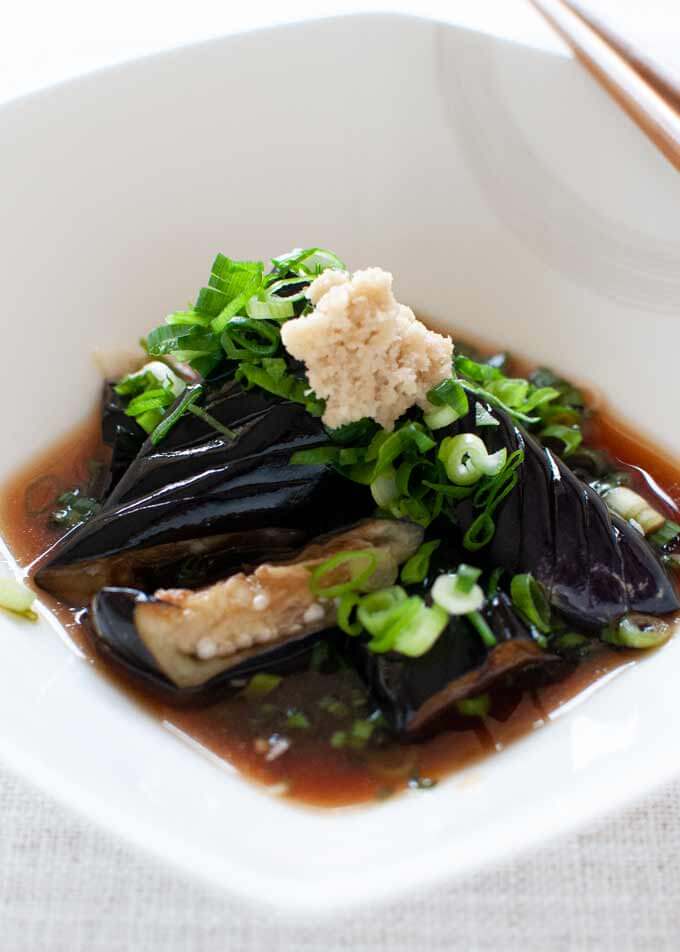
Japanese Fried Eggplant is the representative eggplant side dish in Japan. It’s called ‘agedashi nasu’ (揚げ出し茄子) in Japanese. The word ‘agedashi’ ( 揚げ出し) is a type of dish that is made by deep frying ingredients and eating with a dashi based sauce.
‘Age’ ( 揚げ) means deep fry and ‘dashi’ ( 出し) comes from dashi stock. And as you probably guessed, ‘nasu’ (茄子) is eggplant.
You might have visited my recipe Japanese Fried Tofu (Agedashi Tofu) that was posted about a year ago. Both dishes are basically the same type of dishes with different ingredients.
Which Eggplants to Use?
Considering the skin texture and the size of the eggplant, Japanese eggplants would be ideal for Agedashi Nasu if you have access to them.
They are quite small and when vertically halved, become just the right size to be picked up with chopsticks. The skin is also quite tender, even after deep frying.
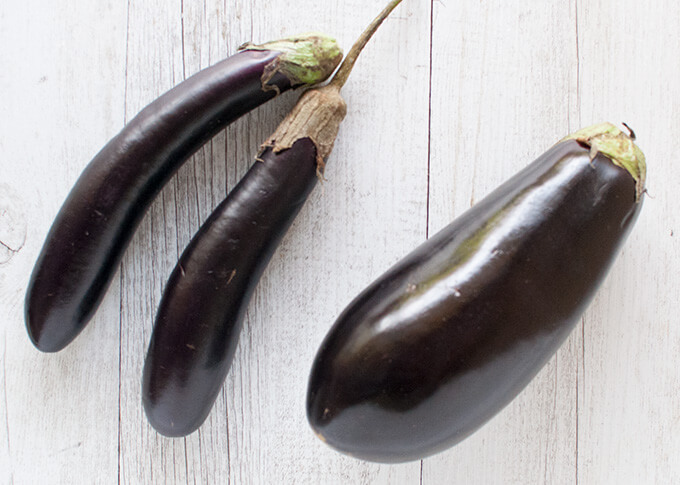
Small (thin long) eggplants (left) and large egg plant (right).
But where I live there are no Japanese eggplants. So, I use either thin long eggplants if available or the large eggplants that are most commonly available in Australia. These eggplants are twice as long as Japanese eggplants.
Large eggplants are about 6-8cm (2½-3”) in diameter and 15-18cm (6-7”) long. Each eggplant weighs about 400g (0.9lb). Some of them are even larger. The thin long eggplants are usually sold as ‘small eggplants’ and the width is similar to Japanese eggplants – about 3-4cm (1¼-1½”). But the length is almost the same as the large eggplants.
Preparing Eggplants
Depending on the type of eggplants, the way to cut them before cooking differs after trimming the stems off.
- Japanese eggplants – cut in half lengthwise.
- Small (thin long) eggplants – cut horizontally into two or three equal length of eggplant pieces, then cut each piece lengthwise in half.
- Large eggplants – cut horizontally into 2-2.5cm (¾-1”) thick discs.
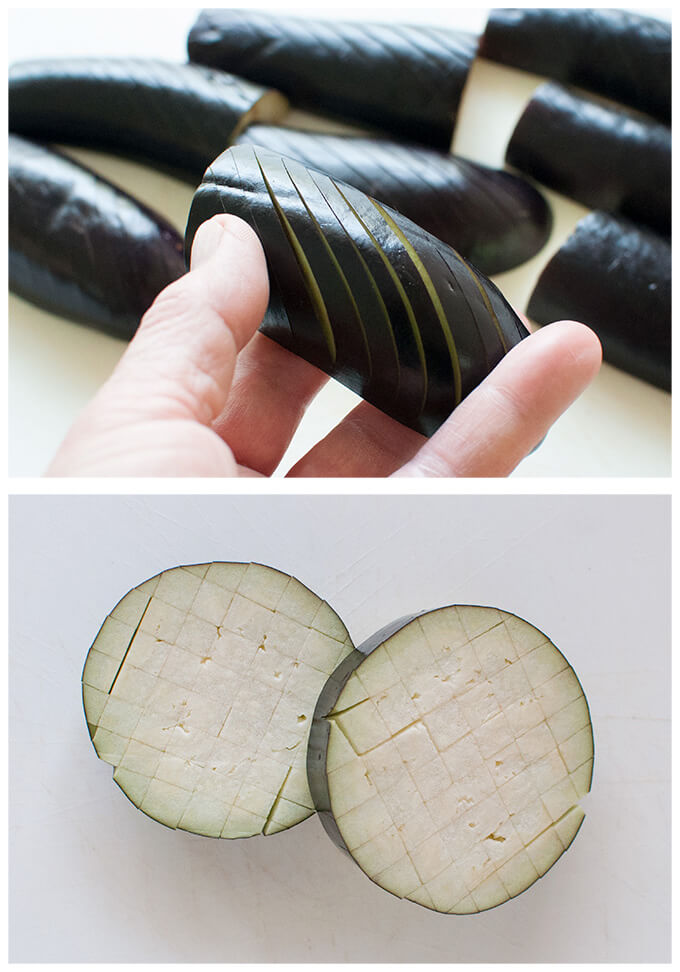
To cook eggplants quickly without burning, eggplant pieces are also scored.
- Japanese and small eggplants – score the skin side diagonally at 5mm (3/16″) intervals. The depth of the incisions should be about half way into the flesh.
- Large eggplants – cut into discs, scoring is different from other types of eggplant pieces. Score one flesh side of the eggplant pieces like a grid at 1-1.5cm (⅜-⅝”) intervals. The depth of the incisions is just over half way into the flesh.
Frying Eggplants
Eggplant pieces don’t require flour or cornflour (corn starch) to deep fry. This is different from Japanese Fried Tofu (Agedashi Tofu) where tofu is coated in cornflour. Frying the ingredient without anything on is called ‘suage’ (素揚げ), which literally means bare frying. The word ‘su’ (素) means bare, as it is, without decoration.
When doing suage, it is important to wipe moisture off the ingredients completely otherwise the oil will splatter.
Unlike cooking Tempura, you don’t need a lot of oil. You can get away with the depth of the oil being about ⅔ of the thickness of the eggplant pieces as a minimum. But I filled the oil in the frying pan to the level where the surface of the eggplant pieces just show above the oil.
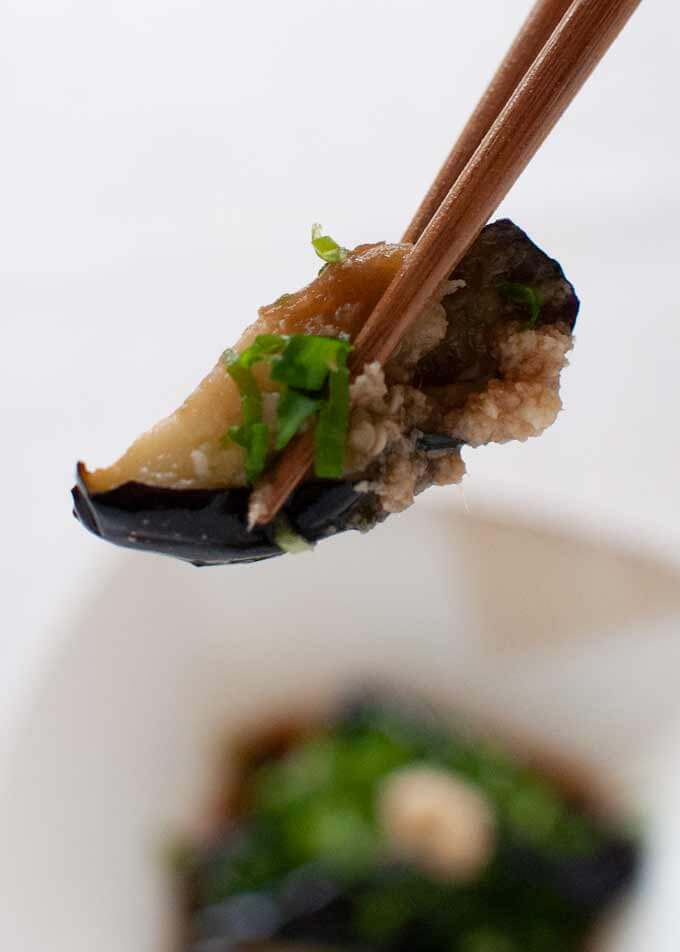
The temperature of the oil is 180C (356F) in my method. May recipes say that it should be deep fried at low temperature, e.g. 160C (320F) for a long time. But when cooked fast at a higher temperature, you can avoid the eggplant skins from getting tough.
Fry the eggplant pieces with the scored side down first for 1.5-2 minutes. Turn them over and cook for 0.5-1 minute. By that time, you can feel that the eggplants are soft inside. Check this by squeezing the piece with chopsticks or tongs. It must be very soft inside because Agedashi Nasu needs to melt in your mouth!
Tough Eggplant Skin
If you fry eggplant pieces a bit too long or the eggplant has very tough skin, you might find that the skin gets a bit crispy and hard to chew after they are deep fried.
There is a remedial step you could take to soften the eggplant skin. After draining the oil from the fried eggplants, place them scored side down on a shallow bowl or a tray and add the dashi sauce to let the eggplant soak up the sauce for 30 minutes or longer.
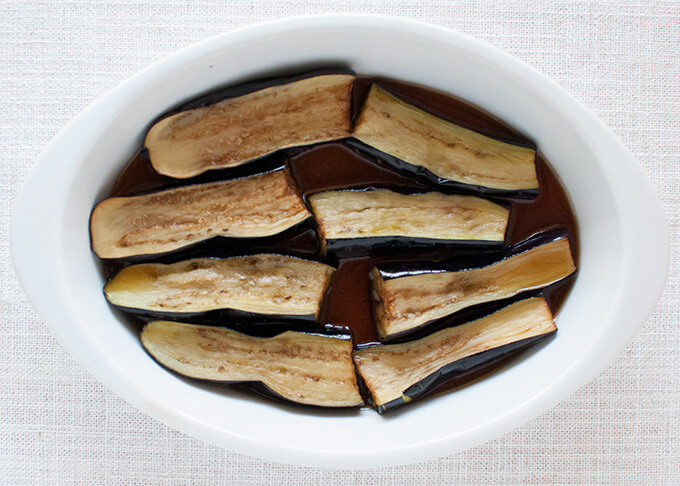 Topping
Topping
The most common toppings for Agedashi Nasu are grated ginger, grated daikon (white radish), finely chopped shallots (scallions), and bonito flakes. You can mix and match these or just use a single topping. They all go well. I used only shallots and ginger today.
Eggplant is one of those vegetables that transforms to something completely different by deep frying. When deep fried eggplant melts in your mouth, you just have to smile with an utter ‘ahh’. It’s that good!
It is also great when served cold or at room temperature.
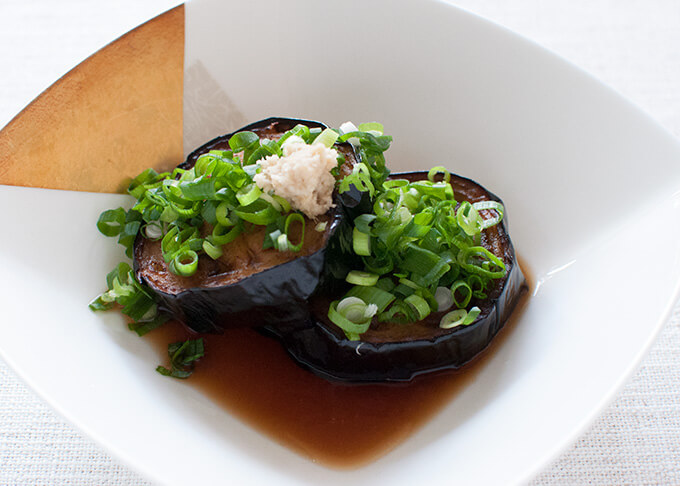
Yumiko![]()
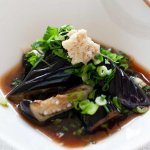
It’s great to serve hot, at room temperature, or even cold.
For vegetarian version, use konbu dashi (note 2).
- 200g (0.4lb) thin long eggplants or Japanese eggplants (note 1)
- Oil for deep frying
- 4 tbsp dashi stock (note 2)
- 1 tbsp soy sauce
- 1 tbsp mirin
- 4 tbsp finely chopped shallots (scallions)
- 1 tsp grated ginger
-
Add the Dashi Sauce ingredients to a small saucepan and bring it to a boil. Turn off the heat and put aside.
-
Wash and wipe the moisture off the eggplants completely with paper towel. Trim stem off the eggplants.
-
If your eggplants are thin long eggplants, cut them horizontally into two or three pieces of equal length, then cut each piece vertically in half. But if you have Japanese eggplants, just cut each eggplant vertically in half.
-
Place each piece of eggplant on a cutting board facing the flesh side down. Score the skin side of each piece diagonally at 5mm (3/16") intervals. The depth of the incision should be about half way. This will allow the eggplant to cook faster.
-
Heat oil in a frying pan or a shallow saucepan (note 3) to 180C (320F). The depth of oil should be about the thickness of eggplant or a bit shallower.
-
Fry eggplant pieces for about 1.5-2 minutes scored side down, then turn over and cook for 0.5-1 minute until the eggplant becomes very soft inside (note 4).
-
Transfer to a tray with a rack or is lined with paper towel.
-
Place the eggplant pieces skin side up in each serving bowl and pour the dashi sauce over them (note 5).
-
Sprinkle chopped shallots over the eggplant pieces, then grated ginger at the top.
1. If you can only find a fat large eggplant (see the comparison photo in the post), that's OK, too. But you need to prepare, cook, serve differently.
Preparation: Cut the eggplant horizontally into 2-2.5cm (¾-1”) thick discs. If each disc is extremely large, cut in half into semicircle shape. Also, score one side of the flesh like a grid at 1-1.5cm (⅜-⅝”) intervals, with the depth just over half way into the flesh.
Cooking: It will take a bit longer if the size of each piece is large.
Serving: Place the scored side down (see the photo in post).
2. For vegetarian, make dashi stock using konbu (kelp). Please refer to Varieties of Dashi Stock to make vegetarian dashi stock.
3. I used a 23cm (9”) frying pan and I could fry all of the eggplant pieces at once without overcrowding. But you can use a smaller frying pan or saucepan and cook them in batches.
4. Using cooking chopsticks or tongs, gently squeeze the eggplant piece. If it squashes easily, it is cooked through.
5. If you feel that the eggplant skin is a bit tough (this can happen when fried too long or the eggplant is very large), soak the eggplant in the Dashi Sauce, scored side down, before serving, for 30 minutes or more. Then plate them as per the instruction.
How exciting to look back and find this recipe, I ate it last weekend at a local restaurant and really enjoyed it. I will be using your recipe this weekend, I have all the ingredients. Thank you for having supplied this recipe.
Hi Linda,I hope you like it and my version is simpler to what you had in the restaurnat!
What sort of oil do you use?
Hi Jan, any clear oil for deep flying is OK. I used vegetable oil, canal oil, sunflower oil.
Agedashi Nasu is my favorite! It’s not commonly found in Japanese restaurants here in Canada, so thank you for the detailed post on how to make this dish! =)
Hi Trish, agedashi nasu is sooo good, isn’t it? Enjoy cooking!